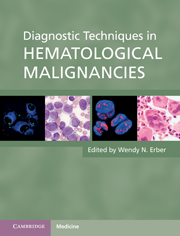Book contents
- Frontmatter
- Contents
- List of Contributors
- Preface
- Part 1 Diagnostic techniques
- Part 2 Hematological malignancies
- 6 The integrated approach to the diagnosis of hematological malignancies
- 7 Acute lymphoblastic leukemia
- 8 Acute myeloid leukemia
- 9 Mature B-cell leukemias
- 10 Mature T-cell and natural-killer cell leukemias
- 11 Lymphoma
- 12 Plasma cell neoplasms
- 13 Chronic myeloid leukemia
- 14 Myeloproliferative neoplasms
- 15 Myelodysplastic syndromes and myelodysplastic/myeloproliferative neoplasms
- Index
- References
10 - Mature T-cell and natural-killer cell leukemias
from Part 2 - Hematological malignancies
Published online by Cambridge University Press: 06 December 2010
- Frontmatter
- Contents
- List of Contributors
- Preface
- Part 1 Diagnostic techniques
- Part 2 Hematological malignancies
- 6 The integrated approach to the diagnosis of hematological malignancies
- 7 Acute lymphoblastic leukemia
- 8 Acute myeloid leukemia
- 9 Mature B-cell leukemias
- 10 Mature T-cell and natural-killer cell leukemias
- 11 Lymphoma
- 12 Plasma cell neoplasms
- 13 Chronic myeloid leukemia
- 14 Myeloproliferative neoplasms
- 15 Myelodysplastic syndromes and myelodysplastic/myeloproliferative neoplasms
- Index
- References
Summary
Introduction
Mature T-cell and natural-killer cell (NK-cell) leukemias consist of T-cell prolymphocytic leukemia (T-PLL), T-cell large granular lymphocytic leukemia (T-LGL), chronic lymphoproliferative disorder of NK-cells (NK-CLPN), adult T-cell leukemia/lymphoma (ATLL) and Sézary syndrome (SS). These disorders comprise a relatively uncommon group of neoplasms which, with the exception of T-PLL, lack a recurrent cytogenetic “marker.” Consequently, the successful diagnosis of a mature T/NK-cell leukemia requires the integration of a variety of parameters.
The evaluation of a patient for a possible T/NK-cell chronic lymphoproliferative disorder is generally triggered by a symptom. Some of these symptoms are non-specific such as fatigue, secondary infection and bleeding, all of which are linked to underlying hematopoietic compromise. Other symptoms are somewhat more disease-specific including skin manifestations in SS, and less often in ATLL (> 50%) and T-PLL (20%). Some patients with mature T/NK-cell leukemias are severely symptomatic (especially patients with T-PLL and ATLL), while other patients may be entirely asymptomatic (NK-CLPN and T-LGL). In these asymptomatic patients, the work-up is generally triggered by an abnormal blood count.
The blood count is typically the starting point for a more “refined” diagnostic work-up. The blood count parameters, including morphological review and differential cell count, highlight an absolute lymphocytosis in patients with T/NK leukemias, or at least an increase in the absolute number of large granular lymphocytes (LGLs) in patients with either T-LGL or NK-CLPN. The white blood cell count (WBC) is typically markedly elevated in patients with T-PLL and at least moderately elevated in patients with ATLL and SS. The WBC is much more variable in patients with T-LGL or NK-CLPN, but there is an absolute increase in LGLs even in cases in which the absolute lymphocyte count is within the normal range.
- Type
- Chapter
- Information
- Diagnostic Techniques in Hematological Malignancies , pp. 191 - 205Publisher: Cambridge University PressPrint publication year: 2010



